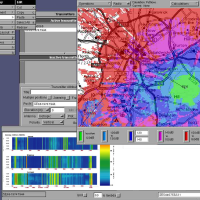Improving Spectrum Usage in Mixed Wireless Systems Through Cognitive Radio
Unassigned radio spectrum below 10GHz is now becoming increasingly scarce, but at the same time studies commissioned by regulators show that large parts of this spectrum are not being used in any specific geographical location. This problem can be solved by Cognitive Radio (CR) techniques, where terminals can dynamically change their transceiver parameters based on interaction with the environment in which they operate, thus using the spectrum in a dynamic manner.
The purpose of this project is to investigate ways of improving the spectrum usage by improving spectrum coexistence and sharing of the various mixed types of communication systems using cognitive radio. The aim is to provide an enhanced grade of service for users and increased system capacity for the operator. Investigations will be carried out on multiple levels, including effective load sharing between mobile, ad hoc local area, and broadband metropolitan area networks (spectrum pooling); the effect of spectrum (interference) management within each family, and possibly the impact of different deployment architectures, e.g. terrestrial or high altitude platform. The benefit to all users gained by a subset of users operating multiband terminals will be determined. The concept of Path Gain Ratio will be utilized to provide a novel and direct measure of the impact on a victim receiver from the activation of transmitter. Orthogonal frequency division multiplexing (OFDM) will be the preferred choice for spectrum pooling, since OFDM has the advantage of flexible sub-carrier allocation and the ability to avoid areas of the spectrum that are occupied by the licensed users. Issues such as spectrum cost and innovative spectrum pricing will be considered. The benefits and drawbacks of using spectrum assignment techniques based on game theory, coexistence etiquettes and bandwidth broker(s) will be evaluated for such mixed CR based systems.
This project will involve Monte Carlo simulation, using MATLAB and/or C and/or OPNET. As well as game theory, other possible analytical techniques could include queuing theory and set theory.
Project outputs
- Innovative ways of operating combined mobile, ad hoc local area, and broadband metropolitan area networks within the same frequency range (spectrum pooling)
- Simulation/analysis dynamic spectrum allocation using cognitive radio illustrating the improvement in the spectrum efficiency
- Statistical distributions of performance for HAP and terrestrial systems.
- Conference (and contributions to journal) papers, and potentially reports to regulators

Members
- Jingxin Chen
- David Grace
- Paul Mitchell
Dates
- October 2005 to
September 2009
Research
